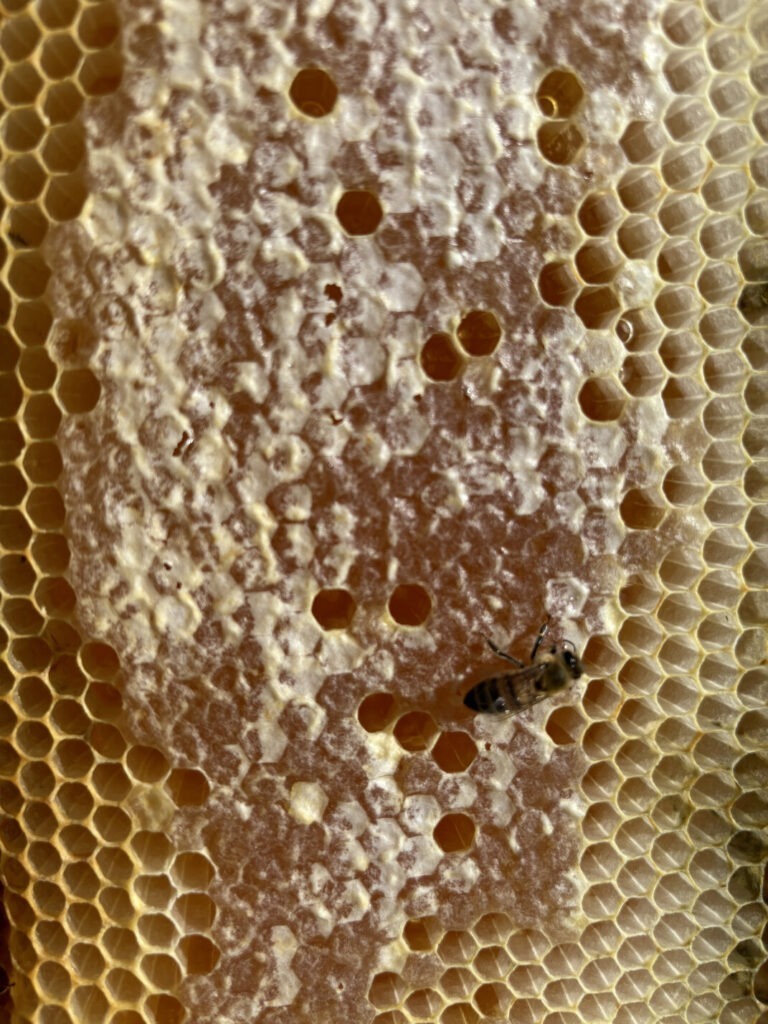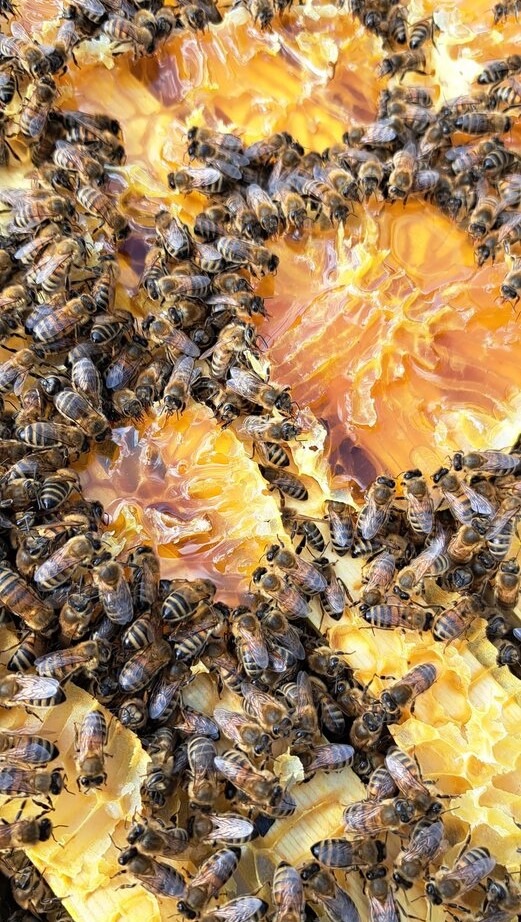
We are pleased to announce that we have adopted a beehive at SW Honey Farms.

The beehive will be located on the south coast in West Sussex from Worthing to Chichester and will feature a plaque with our logo and statement.
The aim is to help combat climate change and improve the world, one bee at a time.
Beehive Updates
14/06/24
With the first inspections completed and honey extraction around the corner, we have received a new beehive update! After an initial inspection of our hive, it appears the bees have been struggling with the slow start of warmer weather and had minimal stores. They had to top them up with a block of fondant to ensure they had enough to get through until the nectar flow started. This was very late this year, with their main spring nectar source being oil seed rape. The oil seed rape had already started to turn before the bees began to work on it, resulting in a halt in nectar collection until the wildflowers began to bloom. The above image shows a frame of honey that has been started and stopped repeatedly, resulting in its current appearance. The bees have sealed the ready-to-eat honey (oil seed rape) and are filling the open cells with fresh nectar, preparing it for water content reduction and eventual sealing.
Due to the constant changes in temperature and weather conditions, which have hindered the bees’ ability to collect nectar, this season is already shaping up to be the least productive in terms of honey collection since SW Honey Farms started. Here’s hoping for a better year next year!
Despite these challenges, the bees are still performing very well in the hive. As long as they have everything they need, they will continue to grow in numbers. Our hive has repeatedly demonstrated its strength and ability to cope with various challenges. They just tend to consume their food quite quickly! These bees will again be used to make more hives at the end of the season, as they seem to almost need a split to ensure they’re not too large going into winter.
Extraction is delayed this year as the bees are working on the later-blooming flowers, but this will happen very soon.
21/03/24 – An insight into what goes into the first steps of the year!
Bee activity picks up as temperatures rise. Understanding this connection helps me anticipate when bees will be more active and how long I have until the potential first honey box goes on. Not for storing honey but to give them space. Once the temperatures are consistent I then go into the next step.
The next step is the hive inspection! Once temperatures consistently reach around 13°C or higher, I open up the hives to check on the bees, their young (called brood), and their food storage. This is the first glimpse at the bees that show me how they are, how effective their treatments have been and how well the worker bees have protected their queen. In this inspection I also check the queen. The queen bee is essential to the colony’s health. I look for signs of her presence, such as eggs, larvae, and capped brood cells. I also check her physical health to check her viability for the new beekeeping season. I also check their food supply. Bees need food to survive, especially before flowers start blooming. I ensure there’s enough honey and pollen stored up and sometimes, I may need to provide additional food.
I also ensure there is good ventilation. Bees need fresh air too! Proper ventilation helps prevent issues like mold inside the hive. The bees use a substance called propolis to cover any holes they deem unnecessary which can sometimes be detrimental to them. I scrap this off as a part of my first inspection to ensure they have this ventilation and if the bees do not like that then they can just cover it back up if they need to. I also scrape the floors of any debris to ensure they have a nice clean hive.
I check for winter pests that may have made their way into the hive to stay warm. This is usually mice that use the bees’ warmth and honey stores to overwinter. I use mouse guards to deter them from entering however they do find a way in sometimes!
31/05/23
As we are now at the end of May the bees are currently expanding at a fast rate. The reason for this is to make sure there is enough workforce in place for the summer honey crop. At this stage they are starting to bring in the spring honey crop and after looking at the pollens coming into the hive I can see it will be a very flavourful spring honey this year. There is an abundance of horse chestnut honey around the apiary which has a very dark red pollen. They are also placed on a crop of field bean which is a light brown colour. I didn’t think any oil seed was around for them to forage on this year but they are bringing in bright golden coloured pollen so somewhere within a three mile radius of where your hive is situated is a crop of oil seed rape!
Our hive currently has 4 honey boxes on them and will probably need more before the spring flow has ended! SW Honey Farms gave them some brand new frames as a form of swarm control and within a couple of weeks they have managed to draw out the combs and the queen has laid it with eggs! Very happy with the quality of these bees and looking forward to seeing how much honey they produce this year.
SW Honey Farms
19/04/23
The 2023 beekeeping season has now begun. I managed to get round all the bees this past weekend to complete the first inspections. Your colony of bees are thriving and at a size now where a honey box is needed. This is my next plan as I need to give them space before they decide they are too cramped and want to swarm.
No queen cells have been found yet in any hives but male drone bees have started to be produced which is the first sign that the swarming season has begun. When I start seeing drone bees being produced I put out swarm traps. These are boxes that are used to lure swarms into them so they have a place to build their new home. This saves them having to hang in a tree and find a new home as there is already a suitable home ready for them.
After inspecting your hive I have found them packing the outside frames with pollen which is the food source for the next generation of bees that will gather the spring honey crop this year. They are looking very healthy and have overwintered perfectly.
This spring they are going to be pollinating acres of field beans that bees love due to the high sugar content of the nectar.
SW Honey Farms
05/02/23
During the winter, bees enter a form of hibernation in which they cluster together inside the hive to stay warm. The bees will form a tight ball around the queen bee and vibrate their wing muscles to generate heat to keep the hive warm. So currently the queen inside your hive is the highest priority and keeping her warm ensures the survival of the colony coming out of the winter. As the temperature drops, the bees will consume more honey to generate more heat.
The colony significantly reduces in population and the worker bees die off leaving only the queen and a group of young bees surviving the winter to build into spring.
It’s important to ensure that the colony has enough stored honey to survive the winter, as well as proper insulation and ventilation to prevent moisture buildup inside the hive. I also strap the beehives down to ensure they can withstand the high winds that can blow the roofs off or even topple them over leaving them open to the elements which can cause them to perish. (shown in the image attached)
It’s important to note that the bees’ behavior and survival during the winter can be affected by the local climate and weather conditions and so far with the mild beginning to the winter and rapid decline in temperature, making sure the hive’s food supplies are topped up has been the highest priority over the past couple of months.
This will continue until the temperatures begin to increase and spring is starting to spring. Then the bees can start their new season and fend for themselves by visiting flowers to collect nectar and pollen to build the colony back to full strength.





